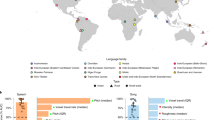Abstract
The purpose of this study was to compare qualitatively and quantitatively the communicative interactions of fathers and mothers with their young child in the naturalistic home environment. Ten couples of similar background served as subjects. Three different settings—(a) mother and child, (b) father and child, and (c) mother and father with child—were arranged and 30-minute tape-recordings were made in the homes with the use of wireless recording equipment. Although differences were found as mothers and fathers interacted alone with their child, the similarities outweighed the differences. When both parents were together with their child, there were even fewer differences. The results indicate that both parents can provide very similar programmable input for the child and that the child acquires languages in a rich and highly varied linguistic environment.
Similar content being viewed by others
References
Broen, P. A. (1972). The verbal environment of the language-learning child.ASHA Monography, No. 17.
Fodor, J. A. (1966). How we learn to talk: Some simple ways. In F. Smith & G. A. Miller (Eds.),The genesis of language. Cambridge, Massachusetts: M. I. T. Press.
Friedlander, B. Z., Jacobs, A. C., Davis, B. B., and Wetstone, H. S. (1972). Time-sampling analysis of infants' natural language environments in the home.Child Development, 43, 730–740.
Hummel, D. D. (1982). Syntactic and conversational characteristics of father's speech.Journal of Psycholinguistic Research, 11, 465–483.
Kraemer, C. A., & James, S. L. (1977).A comparison of language samples elicited at home and in the clinic. Paper presented at the American Speech-Language and Hearing Association Convention, Chicago.
Landes, J. E. (1975). Speech addressed to children: Issues and characteristics of parental input.Language Learning, 25, 355–379.
Lenneberg, E. (1967).Biological foundations of language. New York: Wiley.
Malone, M. J., & Guy, R. F. (1982). A comparison of mothers' and fathers' speech to their 3-year-old sons.Journal of Psycholinguistic Research, 11, 599–608.
Martlew, M. (1980). Control strategies in dyadic mother/child conversations.Journal of Psycholinguistic Research, 9, 327–347.
Messer, D. J. (1981). The identification of names in maternal speech to infants.Journal of Psycholinguistic Research, 10, 69–77.
Rebelsky, F., & Hanks, C. (1971). Father's verbal interaction with infants in the first three months of life.Child Development, 42, 63–68.
Rondal, J. A. (1980). Fathers' and mothers' speech in early language development.Journal of Child Language, 7, 353–369.
Scott, C., Taylor, A., and White, C. (1975).A comparison of home and clinic gathered language samples. Paper presented at the American Speech-Language and Hearing Convention, Washington, D. C.
Snow, C. E. (1972). Mother's speech to children learning language.Child Development 43, 549–565.
Author information
Authors and Affiliations
Additional information
This research was sponsored by Wichita State University Grant No. 3394-22.
Rights and permissions
About this article
Cite this article
Hladik, E.G., Edwards, H.T. A comparative analysis of mother-father speech in the naturalistic home environment. J Psycholinguist Res 13, 321–332 (1984). https://doi.org/10.1007/BF01068149
Accepted:
Issue Date:
DOI: https://doi.org/10.1007/BF01068149




